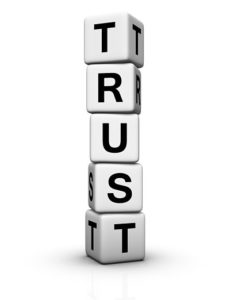But can I trust you?
May 24, 2017
 I can’t guess how many times I’ve written about trust over the past ten years. I’ve talked about the importance of the know • like • trust model, I’ve discussed the connection between trust and a brand’s equity and I’ve explored the role of trust in shortening the sales cycle.
I can’t guess how many times I’ve written about trust over the past ten years. I’ve talked about the importance of the know • like • trust model, I’ve discussed the connection between trust and a brand’s equity and I’ve explored the role of trust in shortening the sales cycle.
Suffice it to say, trust is a cornerstone of marketing success.
But it occurred to me that when I’ve written about trust, it’s been one-sided. I’ve focused on the trust we need from our prospects and customers in order to make them feel safe enough to make that first purchase or repeat buy.
I’ve been ignoring the whole other side of the equation. Trust has to be a two-way street or else it doesn’t work. When you don’t feel trusted – it’s very difficult to trust. Just like in our personal relationships, it’s difficult to let down your guard enough to develop trust when you’re feeling like a criminal, based on how you’re being treated.
Think that’s a little extreme? Think about some of the signage you see in retail locations. “You break it, you buy it” or “video surveillance cameras in use.”
Without meaning to, in a million little ways, many businesses communicate that they don’t really trust their customers.
And if you think we have work to do in that arena – it’s nothing compared to how many organizations treat their employees. It’s pretty tough for them to trust you, trust your brand and create a trusting environment for your customers.
If you want to cultivate trust among your prospects and customers – you have to start by demonstrating trust in your own team and those same prospects and customers.
Let’s look at a couple ideas for each. First, the customers:
Your customer service promise: Call it a pledge, a promise or a policy. Whatever you call it – make sure it’s written in simple English, errs on the assumption that 99% of your customers are honest and good people, and cuts your customers a great deal of slack.
Make it very public – post it on your website, in your store and in your contractual agreements. Celebrate the fact that you believe in your customers and in servicing them with respect and affection.
Arm your employees with both authority and resources: Every time a customer complains or has a bad experience and you make them wait for a manager to resolve it, it feels like you don’t trust them or their story. You also teach them that you don’t have enough confidence in your team to give them the ability to resolve the issue. But when your employees can immediately respond and fix the problem, the customer feels heard and that your organization believed them and their concern.
And now, for showing your employees that you trust them:
Treat them like grown-ups: Flip through your employee manual. Are the rules for adults or does it assume that your team will act like teenagers trying to sneak out after curfew? Too many employee rules are made for the few, not the majority. Create rules that make it clear to your employees that you hold them both capable and accountable.
Ask for help: Nothing says “I believe in you and your abilities” more than asking someone for their help. Involve your employees in key decisions involving customer-facing policies, pricing or R&D options. You can’t just give this tactic lip service. You actually need to listen. The upside of that – you’re going to learn more than you think.
Remember that the know • like • trust model is a two-way street. What are you doing to pave the way to trust for your customers and employees?
More









